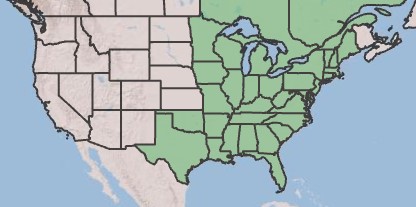Difference between revisions of "Carpinus caroliniana"
(→Ecology) |
(→Taxonomic Notes) |
||
| (4 intermediate revisions by 2 users not shown) | |||
| Line 17: | Line 17: | ||
| range_map_caption = Natural range of ''Carpinus caroliniana'' from USDA NRCS [https://plants.sc.egov.usda.gov/home/plantProfile?symbol=CACA18 Plants Database]. | | range_map_caption = Natural range of ''Carpinus caroliniana'' from USDA NRCS [https://plants.sc.egov.usda.gov/home/plantProfile?symbol=CACA18 Plants Database]. | ||
}} | }} | ||
| − | Common name: American hornbeam | + | Common name: American hornbeam, coastal American hornbeam, inland American hornbeam, muscletree, leantree, lechillo |
==Taxonomic Notes== | ==Taxonomic Notes== | ||
| − | Synonyms: | + | Synonyms: ''Carpinus caroliniana'' ssp. ''caroliniana''; ''C. aroliniana'' ssp. ''virginiana''<ref name=weakley>Weakley, A.S. 2020. Flora of the Southeastern United States. Edition of 20 October 2020. University of North Carolina at Chapel Hill, Chapel Hill, North Carolina.</ref> |
| + | |||
| + | Varieties: ''Carpinus caroliniana'' Walter ''var. caroliniana''; ''C. caroliniana'' Walter ''var. virgniniana'' (Marshall) Fernald<ref name=weakley/> | ||
| + | |||
==Description== | ==Description== | ||
<!-- Basic life history facts such as annual/perennial, monoecious/dioecious, root morphology, seed type, etc. --> | <!-- Basic life history facts such as annual/perennial, monoecious/dioecious, root morphology, seed type, etc. --> | ||
| Line 26: | Line 29: | ||
==Ecology== | ==Ecology== | ||
===Habitat=== | ===Habitat=== | ||
| − | ''C. caroliniana'' is often found as a sub-canopy tree in mesic bottomlands of cypress-hardwood forests, deciduous forests, and pine flatwoods. It occurs along streams and rivers in deep shade and wet sandy loam.<ref name = fsu> Florida State University Robert K. Godfrey Herbarium database. URL: http://herbarium.bio.fsu.edu. Last accessed: May 2023. Collectors: Loran C. Anderson, Sydney T. Bacchus, R. J. Eaton, Patricia Elliot, Robert K. Godfrey, Bruce Hansen, M. Hennis, R. Kral, R. S. Mitchell, B. Moore, Gwynn W. Ramsey, James D. Ray, Jr., P. L. Redfearn, Jr., Deborah R. Shelley, Cecil R. Slaughter, C. E. Smith, C. E. Wood, and Richard P. Wunderlin. States and counties: Florida: Calhoun, Clay, Franklin, Gadsden, Hernando, Jackson, Jefferson, Leon, Levy, Liberty, Nassau, Orange, Putnam, Seminole, Suwannee, Taylor, Volusia, Wakulla, and Washington.</ref> | + | ''C. caroliniana'' is often found as a sub-canopy tree in the mesic bottomlands of cypress-hardwood forests, deciduous forests, and pine flatwoods. It occurs along streams and rivers in deep shade and wet sandy loam.<ref name = fsu> Florida State University Robert K. Godfrey Herbarium database. URL: http://herbarium.bio.fsu.edu. Last accessed: May 2023. Collectors: Loran C. Anderson, Sydney T. Bacchus, R. J. Eaton, Patricia Elliot, Robert K. Godfrey, Bruce Hansen, M. Hennis, R. Kral, R. S. Mitchell, B. Moore, Gwynn W. Ramsey, James D. Ray, Jr., P. L. Redfearn, Jr., Deborah R. Shelley, Cecil R. Slaughter, C. E. Smith, C. E. Wood, and Richard P. Wunderlin. States and counties: Florida: Calhoun, Clay, Franklin, Gadsden, Hernando, Jackson, Jefferson, Leon, Levy, Liberty, Nassau, Orange, Putnam, Seminole, Suwannee, Taylor, Volusia, Wakulla, and Washington.</ref> |
| − | Associated species of ''C. caroliniana'' include ''[[Vaccinium arboreum]]'', ''Crataegus crus-galli'', ''Aesculus'' sp., ''[[Cephalanthus occidentalis]]'', ''[[Nyssa biflora]]'', ''[[Ilex cassine]]'', ''Itea virginica'', ''Decumaria barbara'', ''[[Myrica carolinensis]]'', ''[[ | + | Associated species of ''C. caroliniana'' include ''[[Vaccinium arboreum]]'', ''Crataegus crus-galli'', ''Aesculus'' sp., ''[[Cephalanthus occidentalis]]'', ''[[Nyssa biflora]]'', ''[[Ilex cassine]]'', ''Itea virginica'', ''Decumaria barbara'', ''[[Myrica carolinensis]]'', ''[[Liquidambar styraciflua]]'', ''[[Liriodendron tulipifera]]'', ''[[Quercus virginiana]]'', ''Acer Rubrum'', ''[[Magnolia grandiflora]]'', and ''[[Magnolia virginiana]]''.<ref name=fsu/> |
<!--===Phenology===--> <!--Timing off flowering, fruiting, seed dispersal, and environmental triggers. Cite PanFlora website if appropriate: http://www.gilnelson.com/PanFlora/ --> | <!--===Phenology===--> <!--Timing off flowering, fruiting, seed dispersal, and environmental triggers. Cite PanFlora website if appropriate: http://www.gilnelson.com/PanFlora/ --> | ||
<!--===Seed dispersal===--> | <!--===Seed dispersal===--> | ||
Latest revision as of 08:30, 14 July 2023
| Carpinus caroliniana | |
|---|---|
| Scientific classification | |
| Kingdom: | Plantae |
| Division: | Magnoliophyta - Flowering plants |
| Class: | Magnoliopsida - Dicots |
| Order: | Fagales |
| Family: | Betulaceae |
| Genus: | Carpinus |
| Species: | C. caroliniana |
| Binomial name | |
| Carpinus caroliniana Walter | |

| |
| Natural range of Carpinus caroliniana from USDA NRCS Plants Database. | |
Common name: American hornbeam, coastal American hornbeam, inland American hornbeam, muscletree, leantree, lechillo
Contents
Taxonomic Notes
Synonyms: Carpinus caroliniana ssp. caroliniana; C. aroliniana ssp. virginiana[1]
Varieties: Carpinus caroliniana Walter var. caroliniana; C. caroliniana Walter var. virgniniana (Marshall) Fernald[1]
Description
Distribution
Ecology
Habitat
C. caroliniana is often found as a sub-canopy tree in the mesic bottomlands of cypress-hardwood forests, deciduous forests, and pine flatwoods. It occurs along streams and rivers in deep shade and wet sandy loam.[2]
Associated species of C. caroliniana include Vaccinium arboreum, Crataegus crus-galli, Aesculus sp., Cephalanthus occidentalis, Nyssa biflora, Ilex cassine, Itea virginica, Decumaria barbara, Myrica carolinensis, Liquidambar styraciflua, Liriodendron tulipifera, Quercus virginiana, Acer Rubrum, Magnolia grandiflora, and Magnolia virginiana.[2]
Conservation, cultivation, and restoration
Cultural use
Photo Gallery
References and notes
- ↑ 1.0 1.1 Weakley, A.S. 2020. Flora of the Southeastern United States. Edition of 20 October 2020. University of North Carolina at Chapel Hill, Chapel Hill, North Carolina.
- ↑ 2.0 2.1 Florida State University Robert K. Godfrey Herbarium database. URL: http://herbarium.bio.fsu.edu. Last accessed: May 2023. Collectors: Loran C. Anderson, Sydney T. Bacchus, R. J. Eaton, Patricia Elliot, Robert K. Godfrey, Bruce Hansen, M. Hennis, R. Kral, R. S. Mitchell, B. Moore, Gwynn W. Ramsey, James D. Ray, Jr., P. L. Redfearn, Jr., Deborah R. Shelley, Cecil R. Slaughter, C. E. Smith, C. E. Wood, and Richard P. Wunderlin. States and counties: Florida: Calhoun, Clay, Franklin, Gadsden, Hernando, Jackson, Jefferson, Leon, Levy, Liberty, Nassau, Orange, Putnam, Seminole, Suwannee, Taylor, Volusia, Wakulla, and Washington.